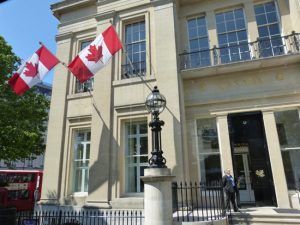
It was one of the quickest checkpoint passages I think I’ve ever experienced. Not that the security officer wasn’t thorough. Not at all. First he asked us about the nature of our visit. We said we wanted to visit the Canada Gallery just beyond the checkpoint. Next, he asked to scan my backpack. No problem there. Then, I offered my passport.
“Canadians?” the security guard said.
I nodded and in we went. My wife and I had just gone through the security check at Canada House, in London, England.
Moments before, we had emerged from the National Art Gallery on the north side of Trafalgar Square – the one dominated by a 52-metre high column featuring a sculpture of Horatio Nelson, Britain’s great war hero, atop it. Well, adjacent to the gallery and off to the Admiral’s one side is the Canadian High Commission. We noticed that the Canada Gallery was open and thought we’d get a taste of home for a few minutes. And it was worth it.
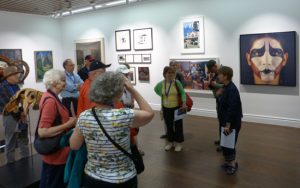
In the gallery we saw paintings by Emily Carr and masks by First Nations artists. But our little expedition wasn’t over. We kind of hoped against hope that the High Commission office might allow the travel group we were leading around London into the facilities for a personally guided tour. Our request went upstairs.
“We’ll do the best we can,” responded Public Diplomacy Counsellor Brigitte Duchesne, who came down from her office to see us personally.
A couple of days later, when Londoners by the thousands celebrated the Queen’s 90th birthday right across the city, Ms. Duchesne welcomed about 25 members of our tour group through the very same security gate, but then beyond the Canada Gallery to see the inner premises of Canada’s oldest diplomatic posting – established in 1880, and located on Trafalgar Square since 1923. In addition to administering much of the immigration from Asia and the Middle East, Canada House acts as a reception facility for Canadian government dignitaries while in the United Kingdom.
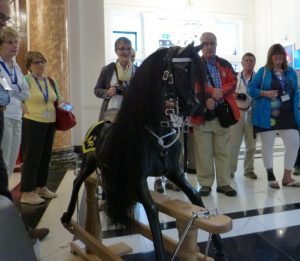
Indeed, earlier the same day we got our guided tour, Governor General David Johnston had visited. During his stay, Johnston accepted a wooden rocking horse named “Burmese,” in honour of the Queen’s favourite steed.
“She’s just visiting,” Brigitte Duchesne said. “She’s a gift from Queen Elizabeth to the RCMP paying them back for all the years they’ve provided her horses.”
As charming as that moment was, the Canada House representative offered an additional insight. At the back of the beautifully crafted and finished rocking horse, we learned, was a hidden compartment in Burmese’s rump specially designed to hold Canadian maple syrup. Next, we were led past a royal chair donated by King George V and then through a recently opened exhibit of paintings (on plywood) complemented by written tributes to British war brides of the Second World War. Then, it was up the floating staircase to view some of the rooms commemorating Canada’s prime ministers and others named after the country’s provinces on the upper floors.
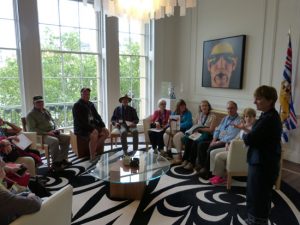
We visited the B.C. Room, the Nova Scotia Room and eventually the largest rooms (because each province is assigned a room roughly comparable to the province’s relative geographic size within Canada) named in honour of Quebec and Ontario. What made each stop memorable was the fact that the décor in each of the provincial rooms reflected that province in every way. The B.C. Room contained only art from B.C. The furnishings in the Ontario and Quebec rooms – from the floor covering to the wood in the boardroom table – were indigenous to those provinces. When we visited the room commemorating Prime Minister John A. Macdonald, the carpet motif had a light colour on one half, and a dark colour on the other half.
“We’ve decided that only white wine will be served on the light side of the carpet and red wine on the dark,” Duchesne added tongue in cheek.
When we strolled through the Laurier Room atop Canada House, we were invited to step outside to a terrace which gave us a panoramic view of many of the iconic sights of downtown London – St. Paul’s Cathedral, Westminster, and the relatively new London Eye Ferris wheel. We paused to take a group photograph and were about to leave when several of us noticed some piled-up boxes on an adjoining rooftop.
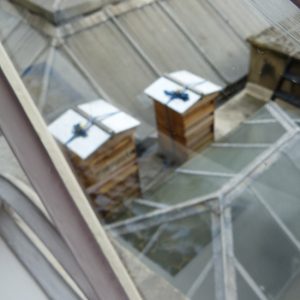
“Oh, those are our beehives,” our guide said.
With bees imported from Canadian apiaries, no doubt.
With all the talk of Brexit this week, it was a pleasant distraction to recall at least one example of the U.K. preserving ties with a long-time ally and Commonwealth partner. I know a rocking horse gift to the RCMP and beehives on the rooftop of Canada House in London may not seem like much, next to international trade associations. But, especially with Canada Day tomorrow, I think it’s comforting to see that a tangible relationship between England and Canada persists.